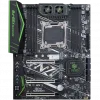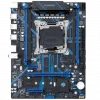LGA 2011, also called Socket R, is a CPU socket by Intel. It replaces Intel's LGA 1366 (Socket B) and LGA 1567 in the performance and high-end desktop and server platforms. The socket has 2,011 protruding pins which touch contact points on the underside of the processor.
Socket R uses QPI to connect the CPU to additional CPUs. DMI 2.0 is used to connect the processor to the PCH. The memory controller and 40 PCIe lanes are integrated on the CPU. On a secondary processor an extra x4 PCIe interface replaces the DMI interface. As with its predecessor LGA1366 there is no provision for integrated graphics.
The socket was released on 14 November 2011, and supports Sandy Bridge E-series processors with 4 memory channels of DDR3-1600, as well as, 40× PCIe 2.0 or 3.0 lanes; The Extreme Edition processor supports six cores with 15 MB of shared L3 cache on a ring bus and a quad-channel DDR3 memory controller. LGA 2011 motherboards have either 4 or 8 DIMM slots which allows for a maximum support of 32GB, 64GB or 128GB of memory. Socket R also has to ensure platform scalability beyond eight cores and 20 MB of cache.
LGA 2011 will also be compatible with future Ivy Bridge-E processors.





